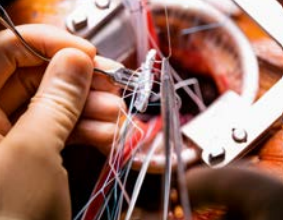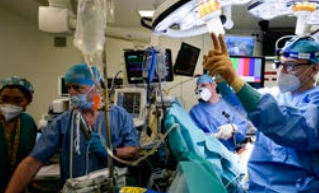New Eyes For Surgeons
NUHCS’s innovative Endopsis Retractor System
enhances minimally invasive heart surgeries
PULSE Issue 39 | June 2022
 The conventional method of reaching
the heart requires a sternotomy surgical approach, where the surgeon cuts
through the breastbone and then
spreads it apart with steel structures
to access the thoracic cavity.
Naturally, the stretching of bone,
muscles, and ligaments results in
pain and discomfort after surgery,
and some necessary downtime is
required for the patient to fully
recover. To overcome such post-operative trauma, various advancements in the medical field including innovative surgical techniques
and technological devices have been
developed over the last decade.
In particular, devices and techniques
that are minimally invasive are preferred due to the smaller incisions
required to access the patient’s
anatomy.
Small incisions in surgery provide
many advantages for patients,
including reduced blood loss,
lower risk of wound infection
and the resulting effect of a more
cosmetically acceptable wound compared to a long scar after an
operation. Minimally invasive surgeries also allow patients to recover
faster and return to their normal
activities sooner.
The conventional method of reaching
the heart requires a sternotomy surgical approach, where the surgeon cuts
through the breastbone and then
spreads it apart with steel structures
to access the thoracic cavity.
Naturally, the stretching of bone,
muscles, and ligaments results in
pain and discomfort after surgery,
and some necessary downtime is
required for the patient to fully
recover. To overcome such post-operative trauma, various advancements in the medical field including innovative surgical techniques
and technological devices have been
developed over the last decade.
In particular, devices and techniques
that are minimally invasive are preferred due to the smaller incisions
required to access the patient’s
anatomy.
Small incisions in surgery provide
many advantages for patients,
including reduced blood loss,
lower risk of wound infection
and the resulting effect of a more
cosmetically acceptable wound compared to a long scar after an
operation. Minimally invasive surgeries also allow patients to recover
faster and return to their normal
activities sooner.
 At the National University Heart Centre, Singapore (NUHCS), the team of
surgeons at the Department of Cardiac, Thoracic and Vascular Surgery
(CTVS) invented a new video camera
system that further enhances such
minimally invasive surgeries.
The Endopsis Retractor System comprises of a hollow shaft that holds
the heart open while a flexible miniature video camera passes through it to provide a wide range of vision
inside the patient’s heart for the surgeon. An advanced type of screw
is then used to hold the camera in
place by pressing against the surface
of the chest, negating the need for
additional steel fixators that can be
heavy and bulky.
With this latest system, the camera
is not only held in place with the
advanced screws, but is also flexible and can be easily maneuvered to
provide different viewing angles for
the surgeon, especially during complex operations.
Current endoscopic instruments use
a 4 to 6 centimetre incision between
the ribs on the side of the chest.
However, the Endopsis Retractor System only requires a 2 to 3 centimetre incision through the groin area to
reach the patient’s heart.
Having used the Endopsis Retractor System for a mitral valve repair
surgery, Dr Chang Guohao, Consultant, Department of CTVS, NUHCS
concurred that the new system is
user-friendly, capable of providing
high-resolution images and allows
the operative field to be de-cluttered
due to its much simpler set-up, all of
which contributes to the ease and
efficiency of the operation process.
This innovative Endopsis Retractor System has now been used for numerous
successful surgeries and will continue
to undergo clinical trials at NUHCS
to further enhance the application
process.
At the National University Heart Centre, Singapore (NUHCS), the team of
surgeons at the Department of Cardiac, Thoracic and Vascular Surgery
(CTVS) invented a new video camera
system that further enhances such
minimally invasive surgeries.
The Endopsis Retractor System comprises of a hollow shaft that holds
the heart open while a flexible miniature video camera passes through it to provide a wide range of vision
inside the patient’s heart for the surgeon. An advanced type of screw
is then used to hold the camera in
place by pressing against the surface
of the chest, negating the need for
additional steel fixators that can be
heavy and bulky.
With this latest system, the camera
is not only held in place with the
advanced screws, but is also flexible and can be easily maneuvered to
provide different viewing angles for
the surgeon, especially during complex operations.
Current endoscopic instruments use
a 4 to 6 centimetre incision between
the ribs on the side of the chest.
However, the Endopsis Retractor System only requires a 2 to 3 centimetre incision through the groin area to
reach the patient’s heart.
Having used the Endopsis Retractor System for a mitral valve repair
surgery, Dr Chang Guohao, Consultant, Department of CTVS, NUHCS
concurred that the new system is
user-friendly, capable of providing
high-resolution images and allows
the operative field to be de-cluttered
due to its much simpler set-up, all of
which contributes to the ease and
efficiency of the operation process.
This innovative Endopsis Retractor System has now been used for numerous
successful surgeries and will continue
to undergo clinical trials at NUHCS
to further enhance the application
process.
